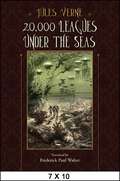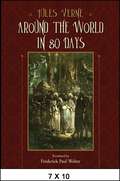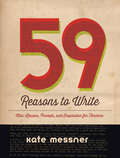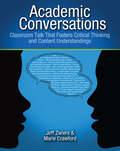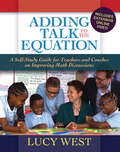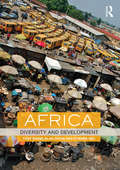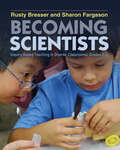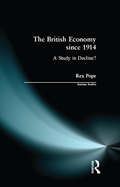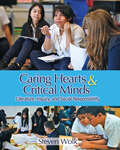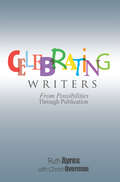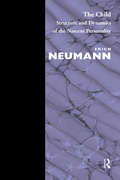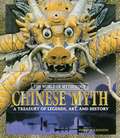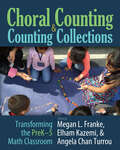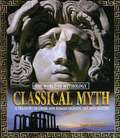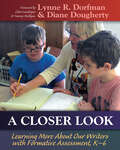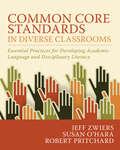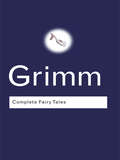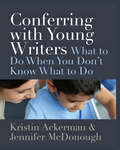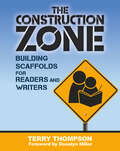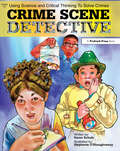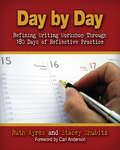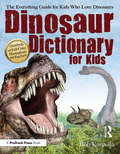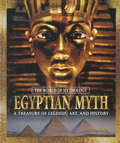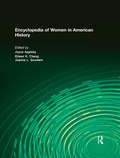- Table View
- List View
20,000 Leagues Under the Seas: A World Tour Underwater (Excelsior Editions)
by Jules VerneWhen an unidentified "monster" threatens international shipping, French oceanographer Pierre Aronnax and his unflappable assistant Conseil join an expedition organized by the US Navy to hunt down and destroy the menace. After months of fruitless searching, they finally grapple with their quarry, but Aronnax, Conseil, and the brash Canadian harpooner Ned Land are thrown overboard in the attack, only to find that the "monster" is actually a futuristic submarine, the Nautilus, commanded by a shadowy, mystical, preternaturally imposing man who calls himself Captain Nemo. Thus begins a journey of 20,000 leagues—nearly 50,000 miles—that will take Captain Nemo, his crew, and these three adventurers on a journey of discovery through undersea forests, coral graveyards, miles-deep trenches, and even the sunken ruins of Atlantis. Jules Verne's novel of undersea exploration has been captivating readers ever since its first publication in 1870, and Frederick Paul Walter's reader-friendly, scientifically meticulous translation of this visionary science fiction classic is complete and unabridged down to the smallest substantive detail.
Around the World in 80 Days: Annotation-friendly Edition (Excelsior Editions)
by Jules VernePart manhunt, part love story, part social satire, but mostly a race against the clock, Around the World in 80 Days is Jules Verne's most rollicking novel. When Phileas Fogg, a wealthy British gentleman who lives his life "with mathemetical predictability," bets the fellow members of his club £20,000 that he can circle the earth in just eighty days, he and his new valet, Passepartout, set out on a whirlwind tour of the globe that will challenge their luck, their wits, and their wallets. En route they ride an elephant smack into an exotic murder cult, steer an undersized sailboat through rampaging storms, and outrun sharp-shooting Sioux, man-eating wolves, and Scotland Yard's dimmest detective—only to see everything go hopelessly haywire until Verne springs the slyest of surprise endings. It's one of the planet's favorite thrillers, and Frederick Paul Walter's reader-friendly translation captures its roguish wit and humor, packages its Americana with exceptional accuracy (one-fourth of the tale takes place in the United States), and is complete and unabridged down to the smallest substantive detail.
Attack of the Chicken Nugget Man
by Kumar R. SathyThis laugh-out-loud children's book is aligned with the new Common Core State Standards. It covers 2nd - 5th grade English Language Arts and Mathematics. Attack of the Chicken Nugget Man: A National Test Prep Adventure is a hilarious story that teaches and references curriculum concepts that students in all states need to learn! This breakthrough educational book tells the story of a struggling third-grader (Chris Robb) who desperately wants to pass a standardized test. Chris's school is a crazy place and his teacher has the strangest name he has ever heard: Ms. Bubblebrain. Every character in the book has a unique personality trait. Smelly Sam stuffs random objects up his nose (sushi, socks, etc), the bus driver waves around his stinky shoe to get the kids to settle down, and the principal harbors an incomprehensible infatuation with strawberry milk. Meanwhile, rumor has it that a mysterious Chicken Nugget Man has been sneaking into schools and causing all kinds of chaos. A task force is created to capture the Chicken Nugget Man. The country's smartest children will be chosen to join the effort because for some reason, no adult has ever seen the Chicken Nugget Man. Chris, who can barely remember his teacher's name, has the odds stacked against him when it comes to passing the big test, but as the reader discovers, he might have a little help, and a little hope, after all. The book has built-in Bloom's Taxonomy critical thinking comprehension questions and silly versions of standardized test prep questions that are written in kid-friendly language. Open-ended questions, creative writing prompts, and drawing activities are included for all kinds of learners. A strong emphasis is placed on character education and every time a character makes a poor choice, the narrator reminds readers of the consequences, encouraging them to suggest more responsible choices. This delightful work of humorous fiction makes learning fun and helps students in all states prepare for standardized tests. It's great for fourth and fifth grade remediation, gifted second graders, after school tutoring, read-aloud, literature circles, family reading nights, and guided reading.
59 Reasons to Write: Mini-Lessons, Prompts, and Inspiration for Teachers
by Kate MessnerIn order to teach writing effectively, teachers must be writers themselves. They must experience the same uncertainty of starting a new draft and then struggling to revise. As they learn to move past the fear of failure, they discover the nervous rush and exhilaration of sharing work with an audience, just as their students do. Only by engaging in the real work of writing can teachers become part of the writing community they dream of creating for their students. Kate Messner's new book, 59 Reasons to Write, shows teachers and librarians who teach writing how to be stronger role models for their students. Writing for my students provided me with appropriate mentor texts to share,- she writes. Writing with my students made me a mentor and a far better teacher.- 59 Reasons to Write grew out of Messner's popular online summer writing camp, Teachers Write. Throughout the book she offers mini-lessons, writing prompts, and bursts of inspiration designed to get you writing every day, whether on your own or as part of a group. Dozens of guest authors also share their writing processes and secrets, from brainstorming ideas and organizing research to developing characters and getting unstuck from writer's block. 59 Reasons to Write is for anyone who has always wanted to write but never managed to get into the habit. Daily warm-ups will help you flex your writing muscles and energize your teaching. As Messner shares, One of the greatest gifts of writing is the way it nudges us to look more closely not only at the world but also at ourselves.
Academic Conversations: Classroom Talk that Fosters Critical Thinking and Content Understandings
by Jeff Zwiers Marie CrawfordConversing with others has given insights to different perspectives, helped build ideas, and solve problems. Academic conversations push students to think and learn in lasting ways. Academic conversations are back-and-forth dialogues in which students focus on a topic and explore it by building, challenging, and negotiating relevant ideas. In Academic Conversations: Classroom Talk that Fosters Critical Thinking and Content Understandings authors Jeff Zwiers and Marie Crawford address the challenges teachers face when trying to bring thoughtful, respectful, and focused conversations into the classroom. They identify five core communications skills needed to help students hold productive academic conversation across content areas: Elaborating and Clarifying Supporting Ideas with Evidence Building On and/or Challenging Ideas Paraphrasing Synthesizing This book shows teachers how to weave the cultivation of academic conversation skills and conversations into current teaching approaches. More specifically, it describes how to use conversations to build the following: Academic vocabulary and grammar Critical thinking skills such as persuasion, interpretation, consideration of multiple perspectives, evaluation, and application Literacy skills such as questioning, predicting, connecting to prior knowledge, and summarizing An academic classroom environment brimming with respect for others' ideas, equity of voice, engagement, and mutual support The ideas in this book stem from many hours of classroom practice, research, and video analysis across grade levels and content areas. Readers will find numerous practical activities for working on each conversation skill, crafting conversation-worthy tasks, and using conversations to teach and assess. Academic Conversations offers an in-depth approach to helping students develop into the future parents, teachers, and leaders who will collaborate to build a better world.
Adding Talk To The Equation: A Self-Study Guide for Teachers and Coaches on Improving Math Discussions
by Lucy WestFor more than 20 years, Lucy West has been studying mathematical classroom discourse. She believes that teachers need to understand what their students are thinking as they grapple with rich mathematical tasks and that the best way to do so is through talking and listening. In this video-rich edition of Adding Talk to the Equation: Discussions and Discovery in Mathematics, she invites teachers into real-life classrooms where all students stay in the game, stay motivated about learning, and ultimately deepen their understanding. Designed for math teachers and coaches in grades 18, this self-study guide showcases elementary and middle school classrooms where teachers inspire even the most reluctant students to share their ideas. Through the stories of skilled teachers, West offers play-by-play commentary as they get more comfortable with new talk moves and learn to tune in and respond to students' math conversations. Although these discussions occur in math class, the strategies can be used to create a respectful, productive environment for any subject area. This video-based resource examines the importance of creating a safe learning environment; the value of thinking, reasoning, and questioning; the role of active, accountable listening; and the necessity of giving all students a you can do this message. West also emphasizes that slowing down, even in the face of time constraints, is crucial for creating a classroom where all students feel they have something to contribute. This guide includes transcripts of the case studies, with insightful commentary from West that gives you a window into her thinking and the complexities of the work she is doing with teachers, as well as her reflections on missed opportunities.
Africa: Diversity and Development (Country Fact Files Ser.country Fact Files)
by Tony Binns Alan Dixon Etienne NelFor many, Africa is regarded as a place of mystery and negative images, where reports of natural disasters and civil strife dominate media attention, with relatively little publicity given to any of the continent’s more positive attributes. Africa has at last begun to receive the depth of interest it has long deserved, in the shape of debates about trade, aid and debt, the ‘Make Poverty History’ campaign, and the UK's ‘Commission on Africa’. But, behind the superficial media façade, Africa is a diverse, complex and dynamic place, with a rich history and a colonial engagement that, although short-lived, was fundamental in determining the long-term future of the continent. At the start of the second decade of the twenty-first century, when the world is engulfed in a major financial crisis, Africa has the dubious distinction of being the world’s poorest continent. This book introduces and de-mystifies Africa’s diversity and dynamism, and considers how its peoples and environments have interacted through time and space. The background and diversity of Africa’s social, cultural, economic, political and environmental systems is examined, as well as key development issues which have affected Africa in the past and are likely to be significant in shaping the future of the continent. These include: the impact of HIV/AIDS; sources of conflict and post-conflict reconstruction; the state and governance; the nature of African economies in a global context and future development trajectories. Africa: Diversity and Development is a refreshing interdisciplinary text which enhances understanding of the background to Africa’s current position and clarifies possible future scenarios. It is richly illustrated throughout with diagrams and plates, and contains a wealth of detailed case studies and current data.
Becoming Scientists: Inquiry-Based Teaching in Diverse Classrooms, Grades 3-5
by Rusty Bresser Sharon FargasonMost important to being a good science teacher is holding the expectation that all students can be scientists and think critically. Providing a thinking curriculum is especially important for those children in diverse classrooms who have been underserved by our educational system. -; Becoming Scientists Good science starts with a question, perhaps from the teacher at the start of a science unit or from the children as they wonder what makes a toy car move, how food decomposes, or why leaves change color. Using inquiry science, children discover answers to their questions in the same way that scientists do-;they design experiments, make predictions, observe and describe, offer and test explanations, and share their conjectures with others. In essence, they construct their own understanding of how the world works through experimentation, reflection, and discussion. Look into real classrooms where teachers practice inquiry science and engage students in the science and engineering practices outlined in the Next Generation Science Standards. Rusty Bresser and Sharon Fargason show teachers how to do the following: Build on students' varied experiences, background knowledge, and readiness Respond to the needs of students with varying levels of English language proficiency Manage a diverse classroom during inquiry science exploration Facilitate science discussions Deepen their own science content knowledgeAs the authors state, Inquiry science has little to do with textbooks and lectures and everything to do with our inherent need as a species to learn about and reflect on the world around us. Join your students on a journey of discovery as you explore your world via inquiry.
The British Economy since 1914: A Study in Decline? (Seminar Studies)
by Rex PopeAn up to date short study which examines the key debates on British economic performance since 1914. Rex Pope considers the indicators and measures involved in assessing economic performance and then looks at issues affecting the economy such as the role of government, British entrepreneurship, the state of world markets, the effect of the two world wars and the importance of cultural attitudes towards industry.
Caring Hearts and Critical Minds: Literature, Inquiry, and Social Responsibility
by Steven WolkImagine if going to school meant more than preparing kids for a test, teaching a canned curriculum, and training students for their future as workers. What if school were also about cultivating students to be caring, community-involved citizens and critical, creative thinkers who love to read? In Caring Hearts & Critical Minds, teacher-author Steven Wolk shows teachers how to help students become better readers as well as better people. I want [my students] to be thinkers and have rich conversations regarding critical issues in the text and be able to formulate opinions regarding these issues, says Leslie Rector, a sixth-grade teacher who collaborated with Wolk on some of the units featured in this book. Wolk demonstrates how to integrate inquiry learning, exciting and contemporary literature, and teaching for social responsibility across the curriculum. He takes teachers step-by-step through the process of designing an inquiry-based literature unit and then provides five full units used in real middle-grade classrooms. Featuring a remarkable range of recommended resources and hundreds of novels from across the literary genres, Caring Hearts & Critical Minds gives teachers a blueprint for creating dynamic units with rigorous lessons about topics kids care about'sfrom media and the environment to personal happiness and global poverty. Wolk shows teachers how to find stimulating, real-world complex texts called for in the Common Core State Standards and integrate them into literature units. I know from experience that a great book changes the reader, says Karen Tellez, an eighth-grade teacher featured in the book. For me, books have helped me escape, fall in love, recover from heartbreak, and have broken open my mind from the age of twelve. . . . I hope [my students] gain better reading comprehension, confidence as readers, connections to the characters and events, a curiosity for the world, and tolerance for others. Caring Hearts & Critical Minds shows teachers how to turn these hopes and goals into reality.
Celebrating Writers: From Possibilities Through Publication
by Ruth AyresWriting begins before students even pick up a pencil, but there are many reasons to stop and rejoice between the idea and the finished project. By helping students celebrate each stage of the writing process and applauding success, we help our students persevere through what can be an extended and challenging process. In their innovative new book, Celebrating Writers , Ruth Ayres and Christi Overman discuss dozens of ways to respond, reflect, and rejoice along the journey to a finished project. This type of celebration nurtures students, makes them better writers, and helps them recognize that writing is a process filled with notable moments, not simply a result where publication is the only marker of success. From traveling notebooks to lunch-table writing, from author interviews with a writing partner to silent reflection, from swapping stories around a campfire to tweeting favorite lines, Ruth and Christi share dozens of fun and effective ways for you and your students to commemorate their progress as writers. As the authors write, It's time to expand the idea of celebration to include the process of writers and the products they create. Let's build an approach that weaves celebration into the heart of all writers. Be ready to learn to refuel the writers in your classroom, even on the tough days.
The Child: Structure and Dynamics of the Nascent Personality (Playaway Children Ser.)
by Erich NeumannIn the closing chapters of The Origins and History of Consciousness Erich Neumann spoke of the importance of demonstrating ‘how the basic laws of the psychic history of mankind are recapitulated in the ontogenetic life history of the individual in our culture.’ Implicit in his words was the promise that an exploration of the detailed psychology of the various stages of life would follow. The Child – an examination of the structure and dynamics of the earliest developments of ego and individuality – is the first of these explorations. In it we progress from the primal relationship of child and mother through to the emergence of the ego-Self constellation, via the child’s relationship to its own body, its Self, the thou and being-in-the-world. We move from the matriarchate to the patriarchate; from participation mystique to the ‘standpoint of the Self around which the ego revolves as around the sun’.
Chinese Myth: A Treasury of Legends, Art, and History (Myth Ser.)
by Philip WilkinsonIn 1978, faced with the pressure to modernize and a declining budget, the Chinese People's Liberation Army (PLA) reluctantly agreed to join China's economic reform drive, expanding its internal economy to market-oriented civilian production. This work examines PLA's role in the economy up to 1998.
Choral Counting & Counting Collections: Transforming the PreK-5 Math Classroom
by Megan L Franke Elham Kazemi Angela Chan TurrouIn this influential book from collaborative authors Megan L Franke, Elham Kazemi, and Angela Chan Turrou, Choral Counting & Counting Collections: Transforming the PreK – 5 Math Classroom, explores ways in which two routines -- Choral Counting and Counting Collections -- can transform your elementary math classroom, your students' math understanding, and your partnerships with families. It paints a vision for how deeply and creatively children can engage with ideas of number and operations and mathematical reasoning through counting. Created with real educators' needs in mind and organized by grade-level band (preschool, K-2, and 3-5), inside this book you'll find: Easy-to-use planning templates to guide teachers in implementing these powerful routinesA variety of student recording sheets for Counting Collections that allow teachers to enact different variations of this activity across the gradesGuides for selecting Choral Counts that support grade-level standards and mathematical goalsGoal charts that provide specific guidance on teacher language and movesAdvice on supporting both students' mathematical and social goals through Choral Counting and Counting CollectionsThe authors have collected the wisdom of math teachers and researchers across the country who explore activities that are both playful and intentional, simple and sophisticated. If you're looking for ways to bring new energy into your math instruction, Choral Counting & Counting Collections: Transforming the PreK - 5 Math Classroom is the perfect book for you and your students.
Classical Myth: A Treasury of Greek and Roman Legends, Art, and History (Myth Ser.)
by Jane BinghamThe World of Mythology series introduces the myths of the world's greatest civilizations. The Classical world of ancient Greece and Rome has had an immeasurable impact on Western culture, but what inspired some of the greatest writers, philosophers, and architects of all time? Gods were not only worshipped, but consulted for both minor problems and victory in battle. The legends of mortals Heracles and Perseus were wrapped up in the lives of the immortals. Art and artifacts, as well as photographs of the landscapes immortalized in the tales, bring the world of Classical myth to life.
A Closer Look: Learning More About Our Writers with Formative Assessment
by Lynne Dorfman Diane DoughertyIn A Closer Look, Lynne Dorfman and Diane Dougherty provide the tools and strategies you need to use formative assessment in writing workshop. Through Lynne and Diane's ideas, you will be able to' establish an environment where students will internalize ways that they can assess their own writing and become independent writers. Lynne and Diane share methods for collecting and managing information, and show practical, simple, and concise ways to document student thinking. In the accompanying online videos, they demonstrate conferences with individual writers, small groups, and whole groups. Quick, easy-to-manage assessment methods emphasize that formative assessment does not have to take a long time to be worthwhile and effective. Vignettes from classroom teachers, principals, and authors add a variety of perspectives and classroom experiences on this important topic. A Closer Look shows that when students are in charge of their own writing process and set and reach their own goals, writing becomes a vibrant, energetic part of the day. '
Common Core Standards in Diverse Classrooms: Essential Practices for Developing Academic Language and Disciplinary Literacy
by Jeff Zwiers Susan O'Hara Robert PritchardThe Common Core State Standards require students to do more with knowledge and language than ever before. Rather than be mere consumers of knowledge, students must now become creators, critics, and communicators of ideas across disciplines. Yet in order to take on these new and exciting roles, many students need daily teaching with an extra emphasis on accelerating their academic communication skills. Common Core Standards in Diverse Classrooms: Essential Practices for Developing Academic Language and Disciplinary Literacy describes seven research-based teaching practices for developing complex language and literacy skills across grade levels and disciplines: using complex texts, fortifying complex output, fostering academic interaction, clarifying complex language, modeling, guiding, and designing instruction. Most important, you will find clear descriptions and examples of how these essential practices can-;and should-;be woven together in real lessons. The book: Clarifieshow to support the learning of complex language that students need for reaching Common Core and other standardsProvides practical ways to realize the instructional shifts needed with the implementation of new standards in diverse classroomsIncludes frameworks and descriptions on how to develop students' complex language, speaking, and writingHelps maximize strategies and tools for building system-wide capacity for sustained growth in the practicesCommon Core Standards in Diverse Classrooms is a concise guide for helping us improve our practices to strengthen two vital pillars that support student learning: academic language and disciplinary literacy.
Complete Fairy Tales (Routledge Classics)
by Jacob Grimm Wilhelm GrimmThe tale of 'Cinderella' is told wherever stories are still read aloud and everyone is familiar with 'Rapunzel' and 'The Golden Goose', but who has heard all the wonderful stories collected by the Brothers Grimm? Well, here's your chance, for within these covers you will find every one of their 210 tales, in all their enchantment and rapture, terror and wisdom, tragedy and beauty.
Conferring with Young Writers: What to Do When You Don't Know What to Do
by Kristin Ackerman Jennifer McDonoughIf you've ever sat down to confer with a child and felt at a loss for what to say or how to help move him or her forward as a writer, this book is for you. If you are a strong teacher of writing but are not seeing results from your students, this book is for you. Authors Kristin Ackerman and Jennifer McDonough have been teaching writing for several years and know that conferring can be a murky and messy process-;perhaps the hardest component of all. Written from the lessons they've learned through hard-won classroom experience-;their mistakes and challenges-;Conferring with Young Writers is based on what Kristin and Jen call the three Fs-: frequency, focus, and follow-up. They've created a classroom management system that offers routine and structure for giving the most effective feedback in a writing conference. This book will help writing teachers-;and students-;learn to break down and utilize the qualities that enable good writing: elaboration, voice, structure, conventions, and focus. The authors also provide the knowledge and skills it takes to confer well, which will help you improve as a writing teacher and give your students the confidence to think of themselves as writers.
Construction Zone: Building Scaffolds for Readers and Writers
by Terry ThompsonInstructional scaffolding is an essential part of teaching literacy. But what is scaffolding exactly? What does it look like in a classroom, and how can we improve the ways we use it? Despite its prominence in the repertoire of teaching strategies, scaffolding remains a vague concept for many teachers. ' In essence, scaffolding is the idea of supporting students as they build independence. In The Construction Zone: Building Scaffolding for Readers and Writers, Terry Thompson identifies four critical processes to deepen your understanding and improve your practice of instructional scaffolding: ·' ' ' ' ' ' ' ' Finding and maintaining a specific focus ·' ' ' ' ' ' ' ' Practicing flexibility in planning and delivering instruction ·' ' ' ' ' ' ' ' Giving constructive feedback in response to student efforts ·' ' ' ' ' ' ' ' Monitoring to ensure that students are working at optimal levels of responsibility Thompson' encourages teachers to enhance their use of the traditional gradual release process through five actionable steps: show, share, support, sustain, and survey, and in doing so provides procedures and techniques to help them establish and maintain strong scaffolds throughout the instructional day. The Construction Zone is written from the teacher's perspective and urges educators to fully embrace their role in the scaffolding process while staying mindful of the effect it has on students. ' Taking a student from dependence upon the teacher to independent learning is what teaching is all about, and instructional scaffolding is key to accomplishing this goal. Regardless of where you are in your understanding of instructional scaffolding, The Construction Zone will raise your level of awareness around your instructional practices and the ways you scaffold students to independence.' '
Crime Scene Detective: Using Science and Critical Thinking to Solve Crimes (Grades 5-8)
by Karen K. SchulzWatch the excitement ripple through your classroom as students use their intellect to find out who committed the "crime" at your school. Enliven your students as they practice critical thinking skills. Students are often taught skills such as the scientific method, scientific research, critical thinking, making observations, analyzing facts, and drawing conclusions in isolation. Studying forensic science allows students to practice these skills and see theories put into practice by using circumstances that model real-life events, meanwhile letting students explore a variety of career options.This exciting unit includes: background information on forensics, exploration of careers in forensic science and law enforcement, a simulation involving a fire in the school library, and instructions for writing your own crime scene simulation. To crack the case, students examine evidence left at the scene, interview suspects (staff members), and use critical thinking to connect all of the clues and eliminate suspects. Students will feel like real investigators with this true-to-life simulation.Let your students solve more mysteries with Mystery Disease, Mystery Science, Detective Club, and The Great Chocolate Caper.Grades 5-8
Day by Day: Refining Writing Workshop Through 180 Days of Reflective Practice
by Ruth Ayres Stacey ShubitzHave you ever wanted your own personal writing coach to help improve your teaching of writing? How about two personal writing coaches? In Day by Day, Stacey Shubitz and Ruth Ayres, creators of the popular blog Two Writing Teachers, guide you through the trials and tribulations of a whole year of writing workshop. ' Day by Day is organized around six fundamental components of writing workshoproutines, mini-lessons, choice, mentors, conferring, and assessment. Each component is broken down into ten-day sections. Each section includes a detailed discussion, a challenge that teachers can apply immediately,' and questions to help teachers assess the process to see what went right, what went wrong, and, most importantly, why.' Ruth and Stacey also provide daily encouragement, support, practical strategies, tips, advice, and everything you need to run an effective writing workshop that meets the needs of all the different writers in your classroom.
Dinosaur Dictionary for Kids: The Everything Guide for Kids Who Love Dinosaurs
by Bob KorpellaPacked with hundreds of illustrated definitions about dinosaurs and the world in which they lived, Dinosaur Dictionary for Kids is certain to spark any kid's enthusiasm for the age of dinosaurs. Explore the Mesozoic era. Learn about dinosaurs that lived on land, animals that swam the waters, and species that patrolled the skies. Find out about dinosaur extinction, how scientists date fossils, and what it takes to become a paleontologist. Dinosaur Dictionary for Kids will be there when it's time to write reports, delve into projects, prepare assignments, or just curl up and discover more about these amazing creatures. Sidebar topics, fun activities, and quick quizzes make learning about dinosaurs even more fun! Divided into sections for quick access to the easy-to-understand definitions and amazing full-color illustrations, Dinosaur Dictionary for Kids is a must-have for any kid's home library.Grades 3-6
Egyptian Myth: A Treasury of Legends, Art, and History (The World Of Mythology Ser.)
by Ann KramerThis in-depth study compares and contrasts how manufacturing and technology have been employed by both major powers and the "Newly Industrialized Countries" since 1945 as an effective tool for sustained economic growth.
Encyclopedia of Women in American History
by Joyce Appleby Eileen Chang Neva GoodwinThis illustrated encyclopedia examines the unique influence and contributions of women in every era of American history, from the colonial period to the present. It not only covers the issues that have had an impact on women, but also traces the influence of women's achievements on society as a whole. Divided into three chronologically arranged volumes, the set includes historical surveys and thematic essays on central issues and political changes affecting women's lives during each period. These are followed by A-Z entries on significant events and social movements, laws, court cases and more, as well as profiles of notable American women from all walks of life and all fields of endeavor. Primary sources and original documents are included throughout.
